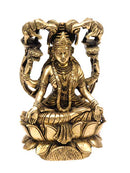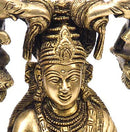Specification
- Product Code :1184
- Material :Brass
- Size :7"H x 4.25"W
Description
Lakshmi, the goddess of wealth, light, wisdom and fortune, as well as luck, beauty and fertility, has been minutely carved out of brass by the sculptor. Seated on the Padmasana, she is engrossed over in meditation. Two elephants are also prominently carved out around her. A graceful and calm lady, the figure is a paradigm of refinement of the art. She is called Padmapriya or one who loves padma or lotus, which refers to purity and spiritual power. Rooted in the mud but blossoming above the water, completely uncontaminated by the mud, the lotus represents spiritual perfection and authority. Furthermore, the lotus seat is a common motif in Hindu iconography. Normally, Hindu gods and goddesses sit or stand upon a lotus that suggests their spiritual authority. Association with the lotus suggests that the being in question: god, human being-has transcended the limitations of the finite world and floats freely in a sphere of purity and spirituality. Shri-Lakshmi thus suggests more than the fertilizing powers of moist soil and the mysterious powers of growth. She suggests a perfection or state of refinement that transcends the material world. She is associated not only with the royal authority but with also spiritual authority, and she combines royal and priestly powers in her presence. The lotus, and the goddess Lakshmi by association, represents the fully developed blossoming of organic life. The birth of goddess Lakshmi is related to an ancient story. Durvasa, the short-tempered sage, once presented Indra, the king of the gods, with a garland of flowers which would never wilt. Indra, in return, gave it to his elephant, Airavata which enraged Durvasa. The sage cursed Indra that he and all the gods would lose their power because it had made them so proud and vain. Due to the curse, the demons vanquished the gods out of the heavens. The defeated gods then went to seek refuge to the Creator Lord Brahma who asked them to churn the ocean of milk, to obtain the nectar of immortality. The gods then went to Lord Vishnu, to seek his assistance. Lord Vishnu took the Avatar Kurma (Tortoise) and supported the Manthara Parvata (mountain ) as a churning rod, while the king of the serpents, Vasuki, became the churning rope. The gods and the demons (under the leadership of the pious and wise King Bali Chakravarti) both helped each other in churning the ocean of milk. Amongst the host of divine gifts which appeared from the ocean, goddess Lakshmi appeared and then chose Shri Vishnu as her consort, as only He had the power to control Maya (illusion). Because of this, Lakshmi is also called the daughter of the sea; since the moon also appeared from the ocean during the churning, the moon is called her brother. Physically, goddess Lakshmi is described as a fair lady, with four arms, seated on a lotus, dressed in fine garments and precious jewels. She has a benign countenance, is in her full youth and yet has a motherly appearance. In the form of Bhudevi or Mother Earth, she supports life and nature. In the form of Sridevi, she is the with the Supreme Lord and is the Goddess of beauty. Bhudevi and Sridevi are mistaken of being seperate Goddesses, but they are only one, Laxmi. As being the wife of Vishnu or Narayan, she is also known as Narayani. As the the Divine Mother of the Universe, she is worshiped for her motherly feelings and power.
Description
Specification
- Product Code :1184
- Material :Brass
- Size :7"H x 4.25"W
Description
Lakshmi, the goddess of wealth, light, wisdom and fortune, as well as luck, beauty and fertility, has been minutely carved out of brass by the sculptor. Seated on the Padmasana, she is engrossed over in meditation. Two elephants are also prominently carved out around her. A graceful and calm lady, the figure is a paradigm of refinement of the art. She is called Padmapriya or one who loves padma or lotus, which refers to purity and spiritual power. Rooted in the mud but blossoming above the water, completely uncontaminated by the mud, the lotus represents spiritual perfection and authority. Furthermore, the lotus seat is a common motif in Hindu iconography. Normally, Hindu gods and goddesses sit or stand upon a lotus that suggests their spiritual authority. Association with the lotus suggests that the being in question: god, human being-has transcended the limitations of the finite world and floats freely in a sphere of purity and spirituality. Shri-Lakshmi thus suggests more than the fertilizing powers of moist soil and the mysterious powers of growth. She suggests a perfection or state of refinement that transcends the material world. She is associated not only with the royal authority but with also spiritual authority, and she combines royal and priestly powers in her presence. The lotus, and the goddess Lakshmi by association, represents the fully developed blossoming of organic life. The birth of goddess Lakshmi is related to an ancient story. Durvasa, the short-tempered sage, once presented Indra, the king of the gods, with a garland of flowers which would never wilt. Indra, in return, gave it to his elephant, Airavata which enraged Durvasa. The sage cursed Indra that he and all the gods would lose their power because it had made them so proud and vain. Due to the curse, the demons vanquished the gods out of the heavens. The defeated gods then went to seek refuge to the Creator Lord Brahma who asked them to churn the ocean of milk, to obtain the nectar of immortality. The gods then went to Lord Vishnu, to seek his assistance. Lord Vishnu took the Avatar Kurma (Tortoise) and supported the Manthara Parvata (mountain ) as a churning rod, while the king of the serpents, Vasuki, became the churning rope. The gods and the demons (under the leadership of the pious and wise King Bali Chakravarti) both helped each other in churning the ocean of milk. Amongst the host of divine gifts which appeared from the ocean, goddess Lakshmi appeared and then chose Shri Vishnu as her consort, as only He had the power to control Maya (illusion). Because of this, Lakshmi is also called the daughter of the sea; since the moon also appeared from the ocean during the churning, the moon is called her brother. Physically, goddess Lakshmi is described as a fair lady, with four arms, seated on a lotus, dressed in fine garments and precious jewels. She has a benign countenance, is in her full youth and yet has a motherly appearance. In the form of Bhudevi or Mother Earth, she supports life and nature. In the form of Sridevi, she is the with the Supreme Lord and is the Goddess of beauty. Bhudevi and Sridevi are mistaken of being seperate Goddesses, but they are only one, Laxmi. As being the wife of Vishnu or Narayan, she is also known as Narayani. As the the Divine Mother of the Universe, she is worshiped for her motherly feelings and power.
Payment & Security
Your payment information is processed securely. We do not store credit card details nor have access to your credit card information.




